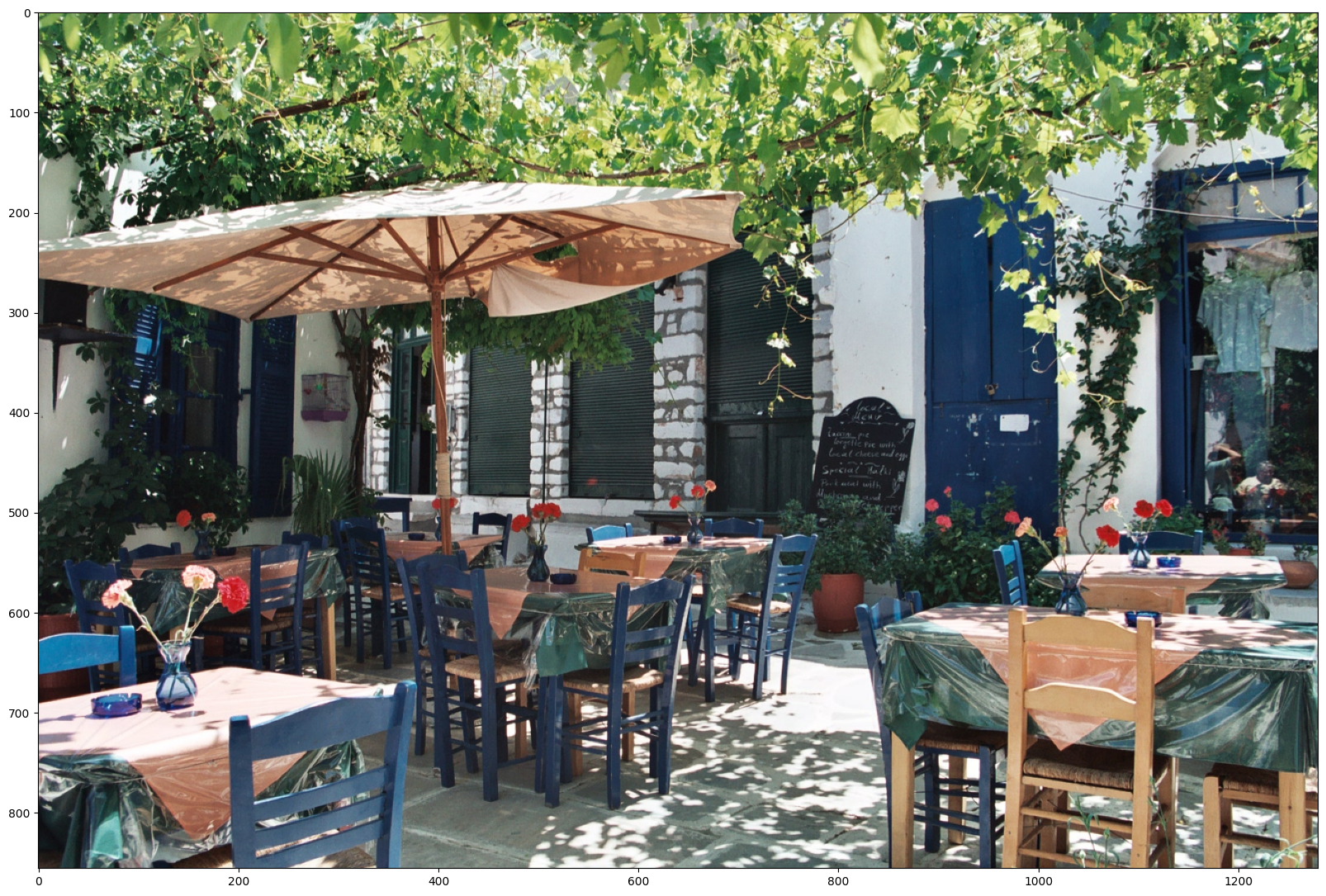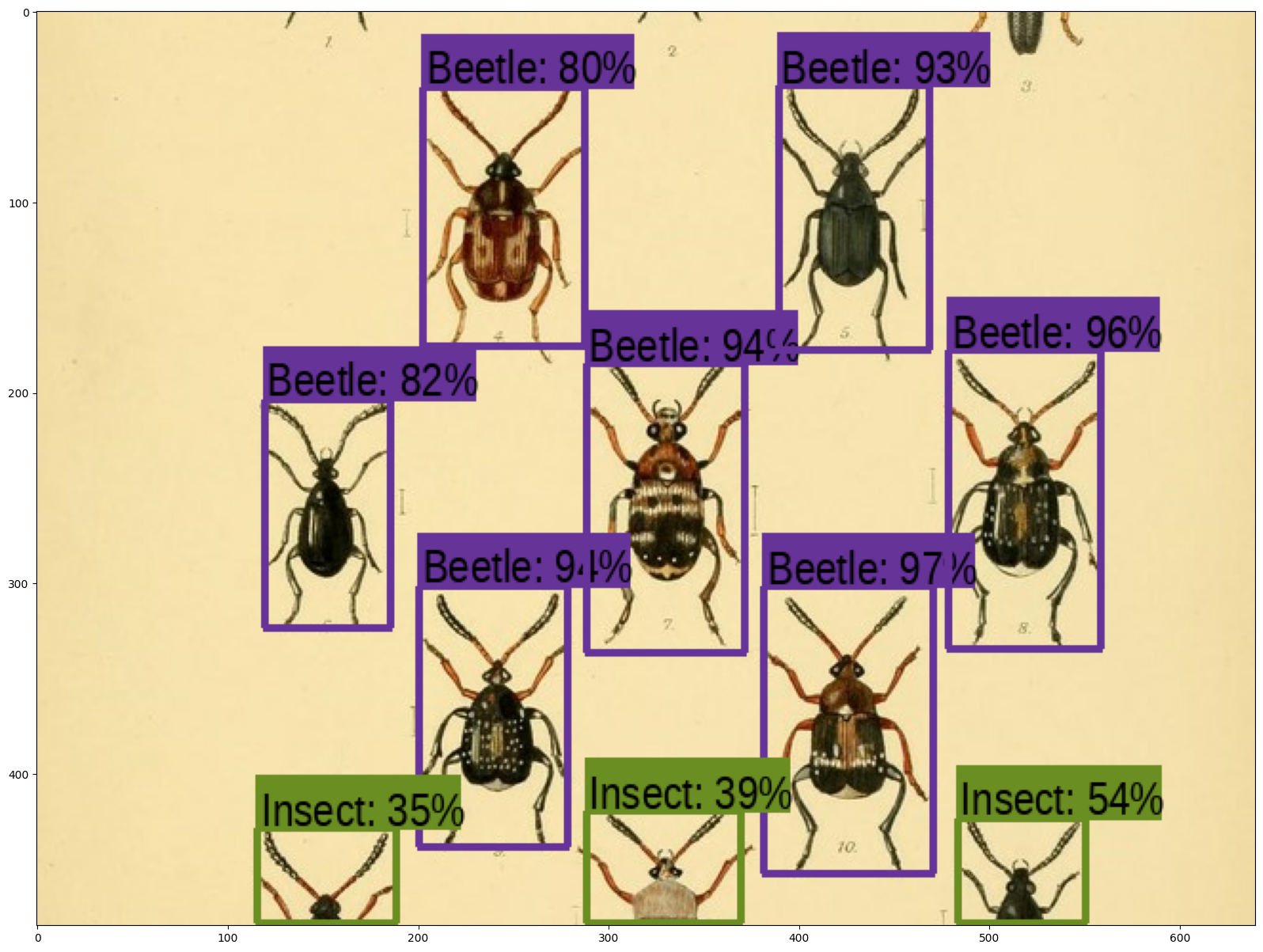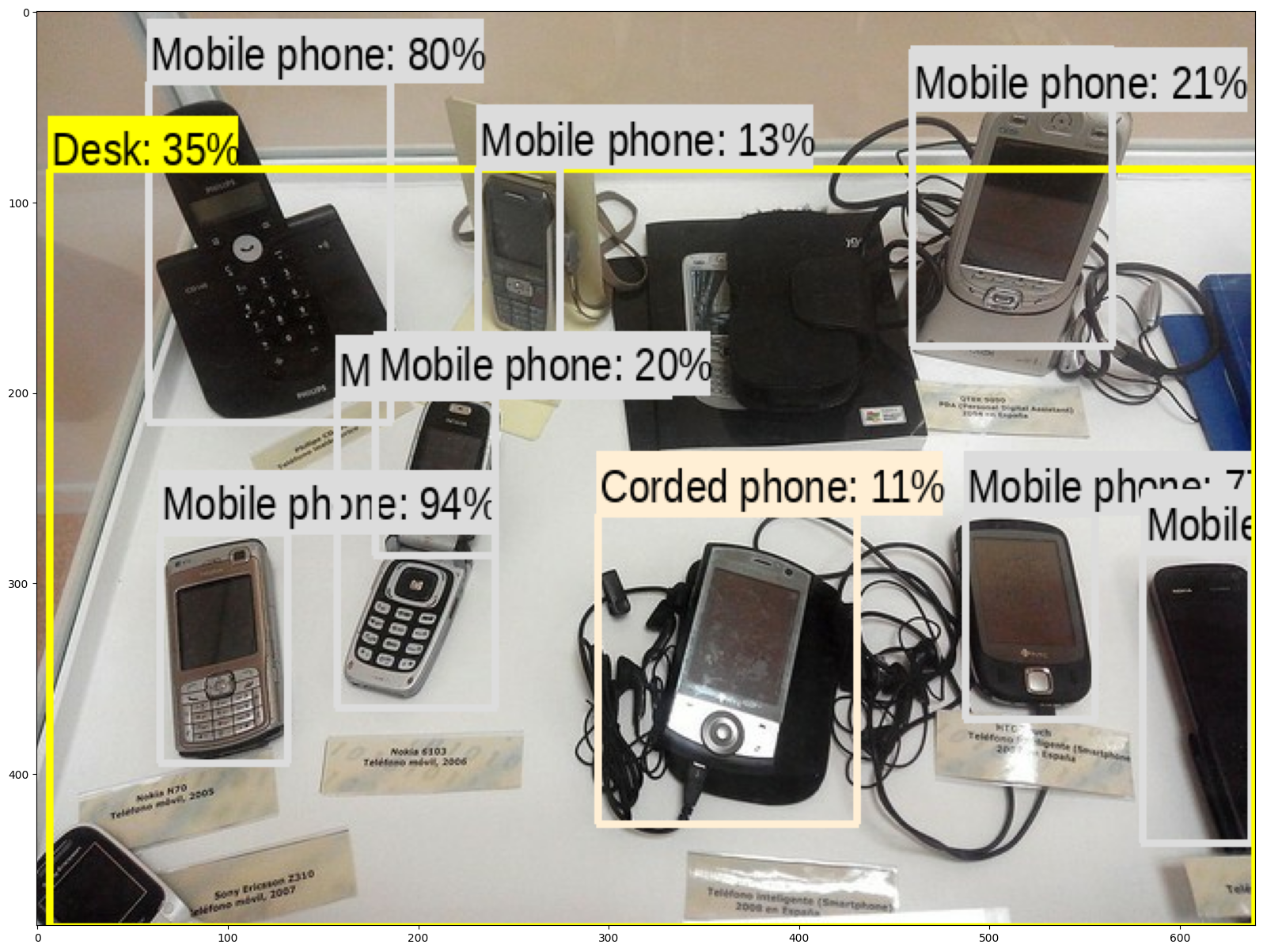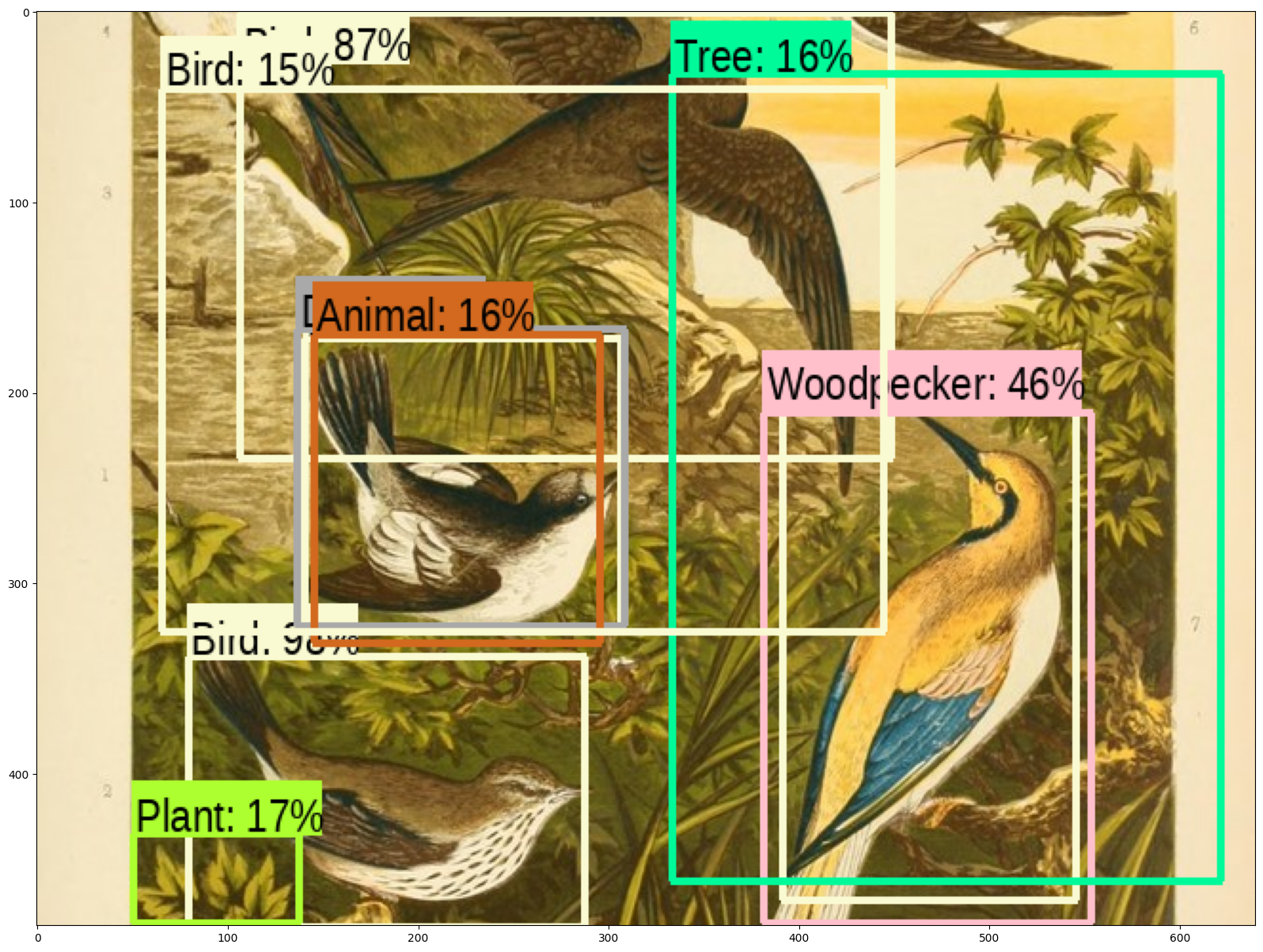 Ver en TensorFlow.org Ver en TensorFlow.org |  Ejecutar en Google Colab Ejecutar en Google Colab |  Ver en GitHub Ver en GitHub |  Descargar cuaderno Descargar cuaderno |  Ver modelos TF Hub Ver modelos TF Hub |
Este Colab demuestra el uso de un módulo TF-Hub entrenado para realizar la detección de objetos.
Configuración
Importaciones y definiciones de funciones
# For running inference on the TF-Hub module.
import tensorflow as tf
import tensorflow_hub as hub
# For downloading the image.
import matplotlib.pyplot as plt
import tempfile
from six.moves.urllib.request import urlopen
from six import BytesIO
# For drawing onto the image.
import numpy as np
from PIL import Image
from PIL import ImageColor
from PIL import ImageDraw
from PIL import ImageFont
from PIL import ImageOps
# For measuring the inference time.
import time
# Print Tensorflow version
print(tf.__version__)
# Check available GPU devices.
print("The following GPU devices are available: %s" % tf.test.gpu_device_name())
2.7.0 The following GPU devices are available: /device:GPU:0
Uso de ejemplo
Funciones de ayuda para descargar imágenes y para visualización.
Código de visualización adaptado de API de detección de objetos TF para la funcionalidad requerida más simple.
def display_image(image):
fig = plt.figure(figsize=(20, 15))
plt.grid(False)
plt.imshow(image)
def download_and_resize_image(url, new_width=256, new_height=256,
display=False):
_, filename = tempfile.mkstemp(suffix=".jpg")
response = urlopen(url)
image_data = response.read()
image_data = BytesIO(image_data)
pil_image = Image.open(image_data)
pil_image = ImageOps.fit(pil_image, (new_width, new_height), Image.ANTIALIAS)
pil_image_rgb = pil_image.convert("RGB")
pil_image_rgb.save(filename, format="JPEG", quality=90)
print("Image downloaded to %s." % filename)
if display:
display_image(pil_image)
return filename
def draw_bounding_box_on_image(image,
ymin,
xmin,
ymax,
xmax,
color,
font,
thickness=4,
display_str_list=()):
"""Adds a bounding box to an image."""
draw = ImageDraw.Draw(image)
im_width, im_height = image.size
(left, right, top, bottom) = (xmin * im_width, xmax * im_width,
ymin * im_height, ymax * im_height)
draw.line([(left, top), (left, bottom), (right, bottom), (right, top),
(left, top)],
width=thickness,
fill=color)
# If the total height of the display strings added to the top of the bounding
# box exceeds the top of the image, stack the strings below the bounding box
# instead of above.
display_str_heights = [font.getsize(ds)[1] for ds in display_str_list]
# Each display_str has a top and bottom margin of 0.05x.
total_display_str_height = (1 + 2 * 0.05) * sum(display_str_heights)
if top > total_display_str_height:
text_bottom = top
else:
text_bottom = top + total_display_str_height
# Reverse list and print from bottom to top.
for display_str in display_str_list[::-1]:
text_width, text_height = font.getsize(display_str)
margin = np.ceil(0.05 * text_height)
draw.rectangle([(left, text_bottom - text_height - 2 * margin),
(left + text_width, text_bottom)],
fill=color)
draw.text((left + margin, text_bottom - text_height - margin),
display_str,
fill="black",
font=font)
text_bottom -= text_height - 2 * margin
def draw_boxes(image, boxes, class_names, scores, max_boxes=10, min_score=0.1):
"""Overlay labeled boxes on an image with formatted scores and label names."""
colors = list(ImageColor.colormap.values())
try:
font = ImageFont.truetype("/usr/share/fonts/truetype/liberation/LiberationSansNarrow-Regular.ttf",
25)
except IOError:
print("Font not found, using default font.")
font = ImageFont.load_default()
for i in range(min(boxes.shape[0], max_boxes)):
if scores[i] >= min_score:
ymin, xmin, ymax, xmax = tuple(boxes[i])
display_str = "{}: {}%".format(class_names[i].decode("ascii"),
int(100 * scores[i]))
color = colors[hash(class_names[i]) % len(colors)]
image_pil = Image.fromarray(np.uint8(image)).convert("RGB")
draw_bounding_box_on_image(
image_pil,
ymin,
xmin,
ymax,
xmax,
color,
font,
display_str_list=[display_str])
np.copyto(image, np.array(image_pil))
return image
Aplicar módulo
Cargue una imagen pública de Open Images v4, guárdela localmente y visualícela.
# By Heiko Gorski, Source: https://commons.wikimedia.org/wiki/File:Naxos_Taverna.jpg
image_url = "https://upload.wikimedia.org/wikipedia/commons/6/60/Naxos_Taverna.jpg"
downloaded_image_path = download_and_resize_image(image_url, 1280, 856, True)
Image downloaded to /tmp/tmpu_02gvdt.jpg.

Elija un módulo de detección de objetos y aplíquelo en la imagen descargada. Módulos:
- FasterRCNN + InceptionResNet V2: alta precisión,
- SSD + MobileNet V2: pequeño y rápido.
module_handle = "https://tfhub.dev/google/faster_rcnn/openimages_v4/inception_resnet_v2/1"
detector = hub.load(module_handle).signatures['default']
INFO:tensorflow:Saver not created because there are no variables in the graph to restore INFO:tensorflow:Saver not created because there are no variables in the graph to restore
def load_img(path):
img = tf.io.read_file(path)
img = tf.image.decode_jpeg(img, channels=3)
return img
def run_detector(detector, path):
img = load_img(path)
converted_img = tf.image.convert_image_dtype(img, tf.float32)[tf.newaxis, ...]
start_time = time.time()
result = detector(converted_img)
end_time = time.time()
result = {key:value.numpy() for key,value in result.items()}
print("Found %d objects." % len(result["detection_scores"]))
print("Inference time: ", end_time-start_time)
image_with_boxes = draw_boxes(
img.numpy(), result["detection_boxes"],
result["detection_class_entities"], result["detection_scores"])
display_image(image_with_boxes)
run_detector(detector, downloaded_image_path)
Found 100 objects. Inference time: 37.78577899932861

Mas imagenes
Realice inferencias en algunas imágenes adicionales con seguimiento del tiempo.
image_urls = [
# Source: https://commons.wikimedia.org/wiki/File:The_Coleoptera_of_the_British_islands_(Plate_125)_(8592917784).jpg
"https://upload.wikimedia.org/wikipedia/commons/1/1b/The_Coleoptera_of_the_British_islands_%28Plate_125%29_%288592917784%29.jpg",
# By Américo Toledano, Source: https://commons.wikimedia.org/wiki/File:Biblioteca_Maim%C3%B3nides,_Campus_Universitario_de_Rabanales_007.jpg
"https://upload.wikimedia.org/wikipedia/commons/thumb/0/0d/Biblioteca_Maim%C3%B3nides%2C_Campus_Universitario_de_Rabanales_007.jpg/1024px-Biblioteca_Maim%C3%B3nides%2C_Campus_Universitario_de_Rabanales_007.jpg",
# Source: https://commons.wikimedia.org/wiki/File:The_smaller_British_birds_(8053836633).jpg
"https://upload.wikimedia.org/wikipedia/commons/0/09/The_smaller_British_birds_%288053836633%29.jpg",
]
def detect_img(image_url):
start_time = time.time()
image_path = download_and_resize_image(image_url, 640, 480)
run_detector(detector, image_path)
end_time = time.time()
print("Inference time:",end_time-start_time)
detect_img(image_urls[0])
Image downloaded to /tmp/tmpuxkybwg_.jpg. Found 100 objects. Inference time: 1.385962724685669 Inference time: 1.8049812316894531

detect_img(image_urls[1])
Image downloaded to /tmp/tmp3wrs8a5l.jpg. Found 100 objects. Inference time: 0.8379817008972168 Inference time: 1.2247464656829834

detect_img(image_urls[2])
Image downloaded to /tmp/tmpu5bhhlnw.jpg. Found 100 objects. Inference time: 0.8334732055664062 Inference time: 1.394953966140747


